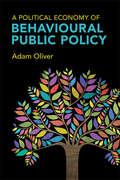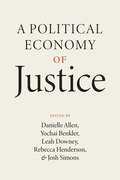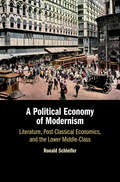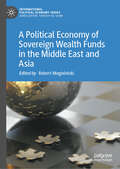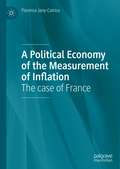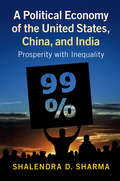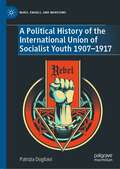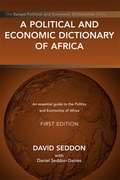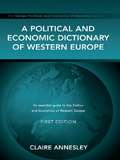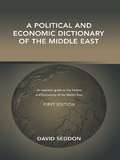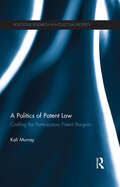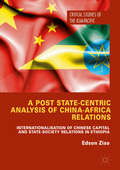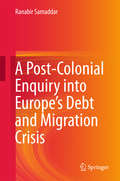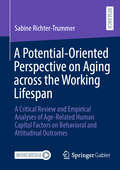- Table View
- List View
A Political Economy of Behavioural Public Policy
by Adam OliverBehavioural public policy has thus far been dominated by approaches that are based on the premise that it is entirely legitimate for policymakers to design policies that nudge or influence people to avoid desires that may not be in their own self- interest. This book argues, instead, for a liberal political economy that radically departs from these paternalistic frameworks. Oliver argues for a framework whereby those who impose no substantive harms on others ought to be free of manipulative or coercive interference. On this view, BPP does not seek to “correct” an individual's conception of the desired life. This book is the third in a trilogy of books by Adam Oliver on the origins and conceptual foundations of BPP.
A Political Economy of Contemporary Capitalism and its Crisis: Demystifying Finance (Routledge Frontiers of Political Economy #172)
by John Milios Dimitris P Sotiropoulos Spyros LapatsiorasThe recent financial meltdown and the resulting global recession have rekindled debates regarding the nature of contemporary capitalism. This book analyses the ongoing financialization of the economy as a development within capitalism, and explores the ways in which it has changed the organization of capitalist power. The authors offer an interpretation of the role of the financial sphere which displays a striking contrast to the majority of contemporary heterodox approaches. Their interpretation stresses the crucial role of financial derivatives in the contemporary organization of capitalist power relations, arguing that the process of financialization is in fact entirely unthinkable in the absence of derivatives. The book also uses Marx’s concepts and some of the arguments developed in the framework of the historic Marxist controversies on economic crises in order to gain an insight into the modern neoliberal form of capitalism and the recent financial crisis. Employing a series of international case studies, this book will be essential reading for all those with an interest in the financial crisis, and all those seeking to comprehend the workings of capitalism.
A Political Economy of Forest Resource Use: Case Studies of Social Forestry in Bangladesh (Routledge Revivals)
by Niaz Ahmed KhanPublished in 1998. An International monograph publishing series covering new research into the ‘green’ issues such as government, corporate and public responses to environmental hazards, the economics of green policies and the effectiveness of environmental protection programmes.
A Political Economy of Justice
by Leah DowneyDefining a just economy in a tenuous social-political time. If we can agree that our current social-political moment is tenuous and unsustainable—and indeed, that may be the only thing we can agree on right now—then how do markets, governments, and people interact in this next era of the world? A Political Economy of Justice considers the strained state of our political economy in terms of where it can go from here. The contributors to this timely and essential volume look squarely at how normative and positive questions about political economy interact with each other—and from that beginning, how to chart a way forward to a just economy. A Political Economy of Justice collects fourteen essays from prominent scholars across the social sciences, each writing in one of three lanes: the measures of a just political economy; the role of firms; and the roles of institutions and governments. The result is a wholly original and urgent new benchmark for the next stage of our democracy.
A Political Economy of Justice
by Leah DowneyDefining a just economy in a tenuous social-political time. If we can agree that our current social-political moment is tenuous and unsustainable—and indeed, that may be the only thing we can agree on right now—then how do markets, governments, and people interact in this next era of the world? A Political Economy of Justice considers the strained state of our political economy in terms of where it can go from here. The contributors to this timely and essential volume look squarely at how normative and positive questions about political economy interact with each other—and from that beginning, how to chart a way forward to a just economy. A Political Economy of Justice collects fourteen essays from prominent scholars across the social sciences, each writing in one of three lanes: the measures of a just political economy; the role of firms; and the roles of institutions and governments. The result is a wholly original and urgent new benchmark for the next stage of our democracy.
A Political Economy of Justice
by Leah DowneyDefining a just economy in a tenuous social-political time. If we can agree that our current social-political moment is tenuous and unsustainable—and indeed, that may be the only thing we can agree on right now—then how do markets, governments, and people interact in this next era of the world? A Political Economy of Justice considers the strained state of our political economy in terms of where it can go from here. The contributors to this timely and essential volume look squarely at how normative and positive questions about political economy interact with each other—and from that beginning, how to chart a way forward to a just economy. A Political Economy of Justice collects fourteen essays from prominent scholars across the social sciences, each writing in one of three lanes: the measures of a just political economy; the role of firms; and the roles of institutions and governments. The result is a wholly original and urgent new benchmark for the next stage of our democracy.
A Political Economy of Modernism: Literature, Post-Classical Economics, and the Lower Middle-Class
by Ronald SchleiferIn A Political Economy of Modernism, Ronald Schleifer examines the political economy of what he calls 'the culture of modernism' by focusing on literature and the arts; intellectual disciplines of post-classical economics; and institutional structures of corporate capitalism and the lower middle-class. In its wide ranging study focused on modernist writers (Dreiser, Hardy, Joyce, Stevens, Woolf, Wells, Wharton, Yeats), modernist artists (Cézanne, Picasso, Stravinsky, Schoenberg), economists (Jevons, Marshall, Veblen), and philosophers (Benjamin, Jakobson, Russell), this book presents an institutional history of cultural modernism in relation to the intellectual history of Enlightenment ethos and the social history of the second Industrial Revolution. It articulates a new method of analysis of the early twentieth century - configuration and modeling - that reveals close connections among its arts, understandings, and social organizations.
A Political Economy of Sovereign Wealth Funds in the Middle East and Asia (International Political Economy Series)
by Robert MogielnickiThis book on sovereign wealth funds (SWFs) in the Middle East and Asia brings together leading scholars and practitioners focusing on investment trends in two prominent and influential regions of the globe. The resulting political economy mapping of these investment vehicles breaks new ground in elucidating prominent geographic contours of the global SWF sector. The interregional framing likewise reveals the strategic economic significance of SWF-facilitated linkages between the Middle East and Asia. The work probes three cross-cutting themes. The initial chapters explore the dynamics of competition and collaboration amongst Middle Eastern and Asian SWFs. This book then turns to the energy, environmental, and sustainability issues shaping SWF investment behavior. Finally, country-specific chapters examine how and why SWF investments materialize within key markets. These interregional connections enabled by sovereign wealth represent an expanding economic frontier with long-term implications for the Middle East, Asia, and the global economy.
A Political Economy of the Measurement of Inflation: The case of France
by Florence Jany-CatriceInflation should no longer be a politically sensitive indicator. Indeed, since the early 1980s, macroeconomic policies have managed to contain it. Yet the consumer price index (CPI), which is the main indicator for measuring inflation, remains very frequently consulted by citizens, due to its multiple uses. The CPI is used for indexing wages, pensions, but also various contracts such as food pensions. It is also used by National Accounts to deflate macroeconomic values and to provide data in “real” terms. But how is this CPI measured? index? What reforms have happened to give shape to the XXIst century CPI? This book presents the CPI based on the study of the controversies that have marked its history. Set in both the socio-economic and ideas contexts, these controversies show the eminently conventional and political nature of the CPI and, therefore, of many other macroeconomic indicators, such as growth or productivity.
A Political Economy of the Middle East
by John Waterbury Alan Richards Melani Cammett Ishac DiwanThis integrated, analytic text presents a comprehensive analysis transformation and development of the political economy in the Middle East over the past several decades. In this updated third edition of A Political Economy of the Middle East, the book retains its focus on the interaction of economic development processes, state systems, and social actors even as it also:*Documents the many changes in demography, education, labor markets, urbanization, water and agriculture, and international labor migration in the Middle East in recent years;*Considers the effect of rising oil prices on reinforcement of authoritarian governance in the region;*Refines its assessment of "the Washington Consensus" to provide a more nuanced approach to the issue of the shifting balance of state and market in economic growth and reform;*Presents Islamism as a vital force in the region that is nonetheless a vast, diverse social movement with many conflicting participants;*Explores the impact of the Arab Spring and subsequent events to the issues raised throughout the textbook in a wholly new chapter.
A Political Economy of the Middle East
by John Waterbury Alan RichardsThis integrated, analytic text presents a comprehensive analysis of the transformation of the political economy of development in the contemporary Middle East over the past several decades. Extensively rewritten and revised, the third edition of A Political Economy of the Middle East retains a focus on the interaction of economic development processes, state systems, and social actors even as it also: Documents the many changes in demography, education, labor markets, urbanization, water and agriculture, and international labor migration in the Middle East in recent years; Considers the effect of rising oil prices on reinforcement of authoritarian governance in the region; Refines its assessment of "the Washington Consensus” to provide a more nuanced approach to the issue of the shifting balance of state and market in economic growth and reform (in an entirely rewritten Chapter 9); Presents Islamism as a vital force in the region that is nonetheless a vast, diverse social movement with many conflicting participants (in a wholly revised Chapter 14).
A Political Economy of the Middle East
by John Waterbury Alan Richards Melani Cammett Ishac DiwanA landmark analysis of the ongoing socioeconomic transformations of the Middle East, now with an epilogue on the ArabaSpring. "
A Political Economy of the United States, China, and India: Prosperity With Inequality
by Shalendra D. SharmaThe precipitous rise in global and national economic inequality, which the inexorable force of globalization promised to address with affluence and abundance for all, has returned with a vengeance. The problem of worsening socioeconomic inequality and how best to ameliorate this pernicious resurgence occupies center stage of national and international politics. This study investigates the coexistence of high rates of economic growth and unparalleled prosperity (including a review of the decline in poverty levels in China and India and many other developing countries) with rises in income and wealth inequality in the United States, China, and India.<P><P> This book examines the overall effectiveness of the measures taken by these three countries to address such anomalies, and what they should do to tackle the problem of widening inequality. This study breaks new ground by providing an original comparative analysis of the challenges facing the world's three major economies.<P> Addresses why both democratic and authoritarian governance have failed to promote more equitable development.<P> Provides nuanced insights into the roots of inequality crises.<P> Offers solutions to address global economic inequality.
A Political History of the International Union of Socialist Youth 1907–1917 (Marx, Engels, and Marxisms)
by Patrizia DoglianiThis book represents a valuable contribution to the history of the Socialist Second International and, more generally, of European socialism between the Great Depression of the 1880s and WWI. It comes to fill a gap in the scholarship, insofar as it investigates the history of the Socialist Youth International. During the first phase of the making of socialist parties, this organization was in charge of the political and cultural education of the proletarian youth. Capitalizing on an approach based on social, quantitative and political history, and on an analysis of mentalities and languages, the book reconstructs the many-sidedness of the “school of recruits” of the social-democratic and revolutionary movements. The working conditions of youth in Europe, its unionization and economic struggles, the fight against militarism, the pedagogical work, the internationalism and the commitment to maintain peace, and the attitude of young militants towards Bolshevik revolution are some of the themes investigated in the book. It also clarifies the role and the engagement with the issue of the new generation shown by prominent figures of Marxism such as Karl Liebknecht, Jean Jaurès, Henri De Man, Willi Münzenberg, Henriette Roland Holst, and Robert Danneberg. Finally, the book constitutes also a page of European social and political history, reconstructed through the history of the various youth socialisms and their relationship with the Marxist tradition.
A Political and Economic Dictionary of Africa
by David SeddonThis invaluable Dictionary provides an essential guide to the politics and economics of the African continent. Each individual entry provides clear and concise information, and entries are fully cross-referenced to enhance the book's usability. Organizations listed include contact details wherever possible. Key features* Provides authoritative up-to-date information on a region that is changing fast, and for which reliable data is often hard to locate* Each country's recent history and economy are described and analyzed in separate essays. Entries include: Apartheid, Central African Republic, Christianity, Colonialism, Development Aid, Genocide, Great Lakes, International Monetary Fund, Languages, Nelson Mandela, Mining, Tobacco, Uganda. Countries covered in this voume include: Algeria, Angola, Benin, Botswana, Burkina Faso, Burundi, Cameroon, Cape Verde, Central African Republic, Chad, Comoros, Democratic Republic of the Congo, Republic of the Congo, Côte d'Ivoire, Djibouti, Egypt, Equatorial Guinea, Eritrea, Ethiopia, Gabon, Gambia, Ghana, Guinea, Guinea-Bissau, Kenya, Lesotho, Liberia, Libya, Madagascar, Malawi, Mali, Mauritania, Mauritius, Morocco, Mozambique, Namibia, Niger, Nigeria, Rwanda, São Tomé and Príncipe, Senegal, Seychelles, Sierra Leone, Somalia, South Africa, Spanish North Africa (Ceuta and Melilla), Sudan, Swaziland, Tanzania, Togo, Tunisia, Uganda, Zambia and Zimbabwe.
A Political and Economic Dictionary of Latin America
by Peter CalvertThis Dictionary provides an impartial and valuable background to the Latin American region, vital for anyone interested in the current affairs, recent history and economy of this vast area. Entries provide definitions of terms, concepts, names and organizations key to discussions of Central and South America. Covering some 48 countries and territories, this volume offers a unique insight to the political and economic dimensions of this diverse region.
A Political and Economic Dictionary of South Asia: An Essential Guide To The Politics And Economics Of South Asia
by Subrata K. Mitra Jivanta Schottli Siegried WolfThanks to its emerging markets, nuclearization and the internet revolution, South Asia is increasingly at the forefront of current affairs. This invaluable reference source seeks to make the region accessible to business travellers as well as to the general reader. The range of subjects to be covered includes major political processes and events of South Asia (elections and electoral politics, political slang, political parties, diplomacy and territorial divisions), domestic and foreign policy, key personalities, political and economic institutions, sub-national groupings and units (regions, cities, provinces and rural entities), ethnicity and identity, and legal systems (laws and court cases). Key features: * Terms, which are frequently misunderstood in the political and economic processes of South Asia, are explained clearly and succinctly * More than 1,000 entries, covering the key debates, issues, concepts and institutions. Entries include: Bharatiya Janata Party (BJP), Caste System, Corruption, dalits, Electoral System, Federalism, Hindu-Muslim relation, India-US Relation, Kashmir, Liberation Tigers of Tamil Eelam (LTTE), Nuclearization, Privatization, Reserve Bank of India, Sikh, Untouchability, Urbanization, Atal Behari Vajpayee. Countries covered in this volume include: Bangladesh, Bhutan, India, Maldives, Nepal, Pakistan and Sri Lanka.
A Political and Economic Dictionary of Western Europe
by Claire AnnesleyA Political and Economic Dictionary of Western Europe is an invaluable guide for those seeking clarification of terms, or a quick reference source. The range of entries is broad and encompasses the recent history and economy of each country of the region as well as political parties, geographical features, prominent individuals, international organizations and key businesses. It provides over 600 key definitions and presents an overview of the changing political dimensions of Western Europe and its relations with the European Union.
A Political and Economic Dictionary of the Middle East
by David SeddonThis reference volume is the definitive guide to the economics and politics of the Middle East. It provides clear definitions detailing terms, concepts, names and organizations used in relation to current economic or political affairs in the Middle East. Entries define, explain and give further relevant information on countries, regions, ethnic groups, political parties, organizations, policies and disputes.
A Politician in a Leather Suit and the Paradox of Japanese Capitalism
by Karthik Ramanna Matthew ShafferTwo lost decades later, capitalism in Japan embodies peculiar contradictions-preserving wealth and social stability in the face of declining economic power. Scant transparency in Japanese corporate practices plays an important role in this phenomenon. Sometimes justified as an embodiment of Japanese culture, the opacity of Japanese corporations is credited with empowering managers to make long-term business decisions that preserve employment and business relationships and maintain social harmony. But opacity also facilitates fraud and corruption, which erode investor confidence and stifle risk-taking. A flamboyant politician, Kotaro Tamura, attempts to raise public awareness around these tensions, but his provocative style earns him few friends in Japan's conservative political establishment.
A Politics of Patent Law: Crafting the Participatory Patent Bargain (Routledge Research in Intellectual Property)
by Kali MurrayThere has been much written on the impact of international treaties like the Trade Related Aspects on Intellectual Property (TRIPS), which laments the failure of patent systems to respond to the interests of a diverse set of non-profit, public interest, and non-corporate entities. This book examines how patent law can accommodate what James Boyle terms a "politics", that is, "a conceptual map of issues, a rough working model of costs and benefits, and a functioning coalition-politics of groups unified by common interests perceived in apparently diverse situations". A Politics of Patent Law provides a substantive account of the ways in which various types of participatory mechanisms currently operate in patent law, and examines how these participatory mechanisms can be further developed, particularly within a regional and international context. In exploring this, Murray highlights the emergence of constitutional law in international intellectual property law as being at the centre of the patent bargain and goes so far as to argue that the constitutional tradition in intellectual property law is as important as TRIPS. Ultimately, the book sets forth a "tool-box" of participatory mechanisms which would allow for, and foster third party participation in the patent process. This book will be of particular interest to academics, students and practitioners in the field of IP Law.
A Post State-Centric Analysis of China-Africa Relations: Internationalisation of Chinese Capital and State-Society Relations in Ethiopia (Critical Studies of the Asia-Pacific)
by Edson ZisoThis book offers a new alternative to understanding the relationship between China and Africa. Here, the author not only explores the changing nature of Ethiopia's internal politics as a result of Chinese investment and commercial links, but also compellingly questions the existing state-centric macro or strategic investigation of China-Africa relations. By thoroughly reviewing and deploying the 'second image reversed' approach and the relational concept of state power analytical approaches, Ziso challenges the Western-centric Weberian conceptualization of state. This volume presents an eclectic approach to interpret the state transformation in Ethiopia in light of Chinese capital, arguing for a "state in society" framework which does not treat the state as a unitary black box. This analysis challenges the conventional binary staple which is often framed on whether China is the new imperialist power plundering Africa's resources or is Africa's historically all-weather friend. This volume offers an original contribution to knowledge on China's relations with Ethiopia in particular, and with Africa in general.
A Post-Colonial Enquiry into Europe’s Debt and Migration Crisis
by Ranabir SamaddarThis important and topical volume is composed around the debt and migration crisis in Europe in 2015 (known as the Greece crisis), and written almost concurrently as the two crises developed in quick succession. The central argument here is that Europe's present crisis suggests a post-colonial bind, or to put in stronger terms, a post-colonial destiny of Europe. The European situation bears remarkable similarity with the post-colonial condition elsewhere in the world and suggests a strong bond between Europe's present situation and the post-colonial bind in which much of the world finds itself. The purpose of this volume is to examine in the light of 21st century capitalism notions such as debt, crisis, rupture, dialogue, mobilization, neo-liberalism, war and migration, and the old, never to be settled, question of ideology. The volume ends with reflections on Europe's migration crisis, and reinforces the point that a critical post-colonial sense of history, accumulation, globalization, and the resilience of the nation form will help us reflect on the present European crisis, and draw appropriate lessons.
A Post-WTO International Legal Order: Utopian, Dystopian and Other Scenarios
by Meredith Kolsky Lewis Colin B. Picker Peter-Tobias Stoll Junji Nakagawa Rostam J. NeuwirthThis book provides readers with a unique opportunity to explore how the international economic legal order (IELO) may look in a post-WTO world. The substance of this book presupposes (whether correct or not) that the WTO either: (a) Stagnates into the foreseeable future (Doha withers, no new Rounds, at best minor amendments, little new jurisprudence, effective collapse of the DSB); or (b) Falls apart completely. While neither is desirable, the book underlines that it must be conceded that neither is inconceivable. The collapse of the Soviet Union tells us that anything is possible (in 1986 no one foresaw the end of the Cold War - clearly it was a much more significant event than would be the case for the demise of the WTO and the current international economic legal order (IELO)). Similarly, just a year or two before Brexit or the election of US President Donald Trump, no one foresaw those two eventualities. Consequently, a worst-case scenario for the future of the WTO cannot be ignored – rather, it must be explored, as has been done in this book. Indeed, despite most IEL academics’ commitment to multilateralism and specifically to a vibrant and dynamic WTO, academics in the field are now beginning to seriously discuss what a post-WTO world could look like (and it was the project behind this book that first launched those discussions). Accordingly, this examination of the post-WTO world will be of great value to practitioners, governmental and international officials and scholars in the IELO. This is particularly so in an era of increasingly rapid change, during which legal scholarship must also address the future if it wants to contribute creative solutions to the resolution and management of the many serious contemporary problems facing our field.
A Potential-Oriented Perspective on Aging across the Working Lifespan: A Critical Review and Empirical Analyses of Age-Related Human Capital Factors on Behavioral and Attitudinal Outcomes
by Sabine Richter-TrummerConsidering decreasing birth rates and increasing rates of life expectancy, the workforce is rapidly aging – resulting in a more age-diverse labor market. So far, research in IWO-psychology has not fully addressed age-related constructs and issues of new work with longitudinal methods representing changes over time more adequately. To enhance predictions for a rapidly aging workforce, this research focuses on the influence of the potentials of actively aging individuals on frequently cited attitudes and behaviors over the working life span. The results suggest that a more differentiated view of age is partially effective in reducing the probability of turnover intention among IT-employees over time, the age-entrepreneurship relation can be clarified by focusing on the inconsistencies of age and the dimensions of human capital partly contribute to engaging in postretirement work. The outcomes have implications regarding the temporality of aging, entrepreneurial generational identity, calling to work and residuals about postretirement work. Qualitative follow-up research addressing the reasons for turnover intention and work activities retirees experienced as calling seems promising.
